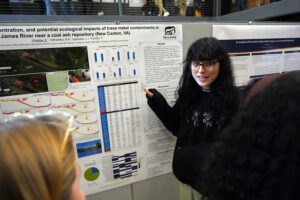
Scientific studies, artistic compilations and ingenious creations came to life across campus last week for the University of Mary Washington’s 18th annual Research and Creativity Symposium.
Junior Summer Orledge studied pollution in local waters. Sophomore Donald Glander used solenoids to create an “electric piano-guitar.” First-year physics and computer science major Ryan Lawrence tapped into multi-wavelength astronomy to predict the formation of future stars.
“It’s really amazing to see the variety of projects out there,” said College of Arts and Sciences Assistant Dean Betsy Lewis, who coordinates the event, held each year on the last day of class. “We’ve got projects from practically every major and department on campus.”
More than 400 students from the College of Arts and Sciences – and from the College of Business and the College of Education – presented the results of the scholarly research and creative endeavors they’ve been cultivating, alongside faculty mentors, throughout the past academic year. A morning filled with oral presentations was followed by a poster session in the Hurley Convergence Center Digital Auditorium, where researchers showed off their studies on glossy panels, sharing their work with fellow students, professors, even the public.
“It’s fun to share what we’ve been working on with the wider UMW community,” said Orledge, an environmental science major investigating contaminants like aluminum, copper and lead that have leached into the James River. “This is such a locally relevant study. It’s something the general public should know about.”
Music recitals, art exhibitions, virtual presentations, a video premiere – even a museum of ancient Mediterranean cultures presented by the Department of Classics, Philosophy and Religion – played out through the day, from the Cedric Rucker University Center to the duPont art gallery.





The College of Education hosted an evening research symposium in Seacobeck Hall, and College of Business presenters shared findings on everything from minimizing waste within the beauty industry to analyzing quarterback salaries. The recent Live Endowed Case Competition was part of the roundup as well.
Last year’s $30 million gift – the largest in University history – from late alumna Irene Piscopo Rodgers ’59 helps support STEM research and frees other funds for work in the arts, humanities and social sciences. The money is used for supplies, travel and other needs for undergraduate research and often pays for students to present at conferences, Lewis said.
“They learn how to gather information, how to synthesize that and how to express it to others,” she said. “And those are just great skills in any career they go into.”

For a full list of presentations, visit the Research and Creativity Symposium website.
To hear College of Arts and Sciences Dean Betsy Lewis and two student presenters discuss the research and plans that go into the day, listen to the April 23, 2024, broadcast of the Town Talk radio show.







